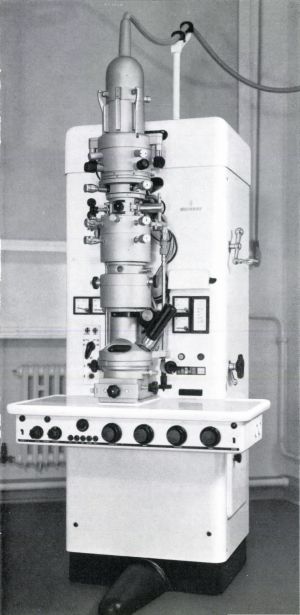Difference between revisions of "Electron Microscope"
| Line 27: | Line 27: | ||
| − | Japan also started deveolping Electron Microscopes, two major Companies stood out, [JEOL] and [Hitachi], which still to this day, produce Electron Microscopes of the highest Quality. Hitachi Pioneered the use of the [Cold Field Emmision Cathode], first seen in their <inser name of first FESEM here>. | + | Japan also started deveolping Electron Microscopes, two major Companies stood out, [[JEOL]] and [[Hitachi]], which still to this day, produce Electron Microscopes of the highest Quality. Hitachi Pioneered the use of the [Cold Field Emmision Cathode], first seen in their <inser name of first FESEM here>. |
Revision as of 19:03, 23 March 2020
General

The Electron Microscope as invented by Ernst Ruska and later refined and diversified by other, is a Microscope which unlike the Light Microscope uses High speed Electrons for the creation of images by various means.
The Electron Microscope can be divided into several Sub Categories
- Transmission Electron Microscope
- Reflection Electron Microscope
- Scanning Electron Microscope
- Emission Electron Microscope
Each of these principles has its own unique advantages and disadvantages. For further information see the related pages.
History
The Electron Microscope was invented in 1934 by German Physascist Ernst Ruska while working for the Siemens Corperation. It evolved from Ruskas findings that a aperture can be magnified by menas of a rotationally symetrical magnetic field, while studying and desining Electron Beam Oscillographs. With the help of Engineer [Max Knoll] and [Bodo von Borries], the observation quickly resulted in a functioning proof of concept aperatus which can be considered the forefather of all electron microscope. All though crude at the time, this apperatus proved the princple discovered by Ruska to be exploitable for the creation of a Microscope.
The apperatus was later Refined numerous times, leading ultimatly to the creation of the [Siemens Elektronen Mikroskop]. This unit was later refined, fallowing World War II into the [ÜM100] Microscope. Simultaniously to the development at Siemens, the German Company AEG with subsequent help from Carl Zeiss, under the leadership of [Otto Rang] and [Hans Schluge], another first generation Microscope was developed. This Microscope subsequently evolved into the AEG Zeiss [EM8]. Unlike the Siemens counterpart, this unit opperated purely by means of the [Electrostatic Lens], where as Ruskas Microscope was based exclusivly on the [Electromagnetic Lens].
Some time latter, the United Kingdom and the American Continent started the development of Electron Microscopes of their own. The British contribution to the world of Electron Microscopy was first started by the Metropolitan-Vickers Corperation, under the leadership of <insert name here>, which created Britains first Electron Microscope, the [EM2].
Meanwhile on the American Continent, the Canadian Scientist James Hillier worked on creating a Microscope of their own, his work was later incorperated into the [RCA] Line of Electron Microscopes.
Some what later the USSR, based on documentation and equipment looted after the conclusion of World War II, begun the development of their own Microscopes. Not much is known about these early Microscopes, but two models have been reported in the <insert name of paper here>. There the <insert first russian microscope here> and <insert Second Microscope here> where discussed. Later Electron Microscope development was moved to what is now the Czchek Republic under the name [Tesla].
Japan also started deveolping Electron Microscopes, two major Companies stood out, JEOL and Hitachi, which still to this day, produce Electron Microscopes of the highest Quality. Hitachi Pioneered the use of the [Cold Field Emmision Cathode], first seen in their <inser name of first FESEM here>.